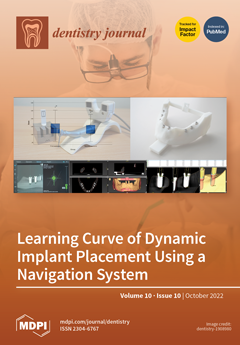Objective: The aim of this study was to compare five toothpastes in terms of alteration of surface roughness and colour of red-wine-stained human enamel over time after brushing simulation. Methods: Stained specimens were randomly divided into five groups (
n = 8): Oral-B Gum and Enamel (C), ZACT Stain Fighter (ZW), Colgate Optic White Volcanic Mineral (CW), Oral-B 3D White Luxe Fresh Breath (3DW), and Thepthai (TW). The colour and surface roughness of the specimens were measured after brushing simulation for four durations; two weeks, one month, six months, and twelve months. Abrasive particles in toothpaste were inspected under a scanning electron microscope. Results: Surface roughness was increased in the specimens that underwent brushing simulation in all groups (
p < 0.05). ZW (6.33 ± 0.98 μm) exerted the most changes in surface roughness for all durations. Other groups showed similar surface roughness at each time point. ΔE
00 and ΔL were increased in all groups until twelve months; however, there were no significant differences between C (ΔE
00 = 30.17 ± 4.16, ΔL = 38.19 ± 4.34), CW (ΔE
00 = 24.25 ± 10.52, ΔL = 31.12 ± 11.00), and TW (ΔE
00 = 29.00 ± 3.96, ΔL = 36.68 ± 4.53) at any time period. Moreover, ZW (ΔE
00 = 45.6 ± 8.01, ΔL = 53.03 ± 6.71) and 3DW (ΔE
00 = 43.6 ± 7.33, ΔL = 51.03 ± 6.47) exhibited a substantial change and were statistically differed from the other groups after four-weeks. Various characteristics of abrasive particles were inspected under SEM. Conclusion: All five toothpastes increased the surface roughness altered the colour of red wine-stained human enamel over time.
Full article






